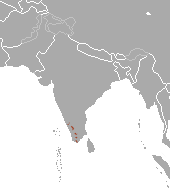| Nilgiri marten | |
|---|---|
 | |
| Scientific classification | |
| Kingdom: | Animalia |
| Phylum: | Chordata |
| Class: | Mammalia |
| Order: | Carnivora |
| Family: | Mustelidae |
| Genus: | Martes |
| Species: | M. gwatkinsii |
| Binomial name | |
| Martes gwatkinsii (Horsfield, 1851) | |
 | |
| Nilgiri marten range | |
| Synonyms | |
Charronia gwatkinsii | |
The Nilgiri marten (Martes gwatkinsii) is the only marten species native to southern India. It lives in the hills of the Nilgiris and parts of the Western Ghats. With only around a thousand members left it is listed as Vulnerable on the IUCN Red List. [1]

